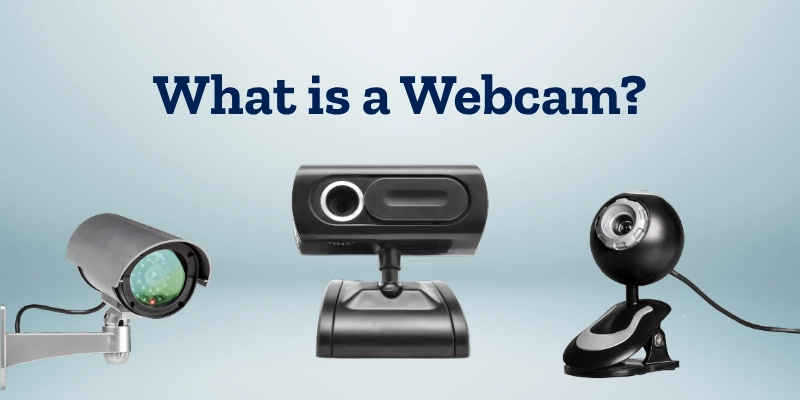What is a Webcam, and how does it work
Published: 30 Sep 2025
Have you ever joined an online class, Zoom meeting, or video call? If yes, then you have already used a webcam.
Today, webcams are very important. People use them for remote work, online learning, social media, and even security.
In this article, we will talk about the meaning of webcam, its types, uses, pros and cons, history, and some common FAQs.
What is a Webcam?
The word webcam comes from two words: “web + camera.” A webcam is a small digital camera that is mainly used for online communication.

It records or streams video so people can see each other over the internet. In simple words, it is a camera for your computer.
How does it work?
A webcam works by capturing video and sending it to the computer through special software. The software then transfers the video online so it can be seen by others.
For example, during a Zoom call, your webcam shows your live video to your friends, teachers, or co-workers.
Built-in vs External Webcams
There are two main types of webcams:
- Built-in Webcams: These are already present in laptops, tablets, and some monitors. They are small, simple, and easy to use.
- External Webcams: These are separate cameras that you connect to your computer using a USB cable. They often provide better video quality and extra features.
History of Webcam
The history of webcams began in 1991 with the famous Cambridge “Coffee Pot Webcam.” Since then, the invention of the webcam has changed online communication forever.
- 1991 – First Webcam: Invented at Cambridge University to watch a coffee pot.
- Early Use: Mainly for video chats and simple online monitoring.
- 2000s Growth: Became popular in homes and offices as internet speed improved.
- Modern Webcams: Built into laptops, tablets, and monitors for easy use.
- Advanced Technology: Today, we have HD and 4K webcams used for remote work, online learning, streaming, and security.
Types of Webcams
There are different types of webcams designed for various needs. From simple built-in cameras to advanced 4K webcams, each type serves a unique purpose.
- Built-in Webcams: Integrated into laptops, tablets, and some monitors. Easy to use but usually lower in quality. (Keyword: built-in webcam)
- External USB Webcams: Connected through USB. Provide better video quality, which is common for streaming and online meetings. (Keyword: built-in webcam vs external webcam)
- Wireless Webcams: Work through Wi-Fi or Bluetooth. Handy for flexible placement without cables.
- Network/IP Webcams: Often used for surveillance and security. They connect directly to a network.
- HD and 4K Webcams: High-resolution cameras made for professional streaming, video production, and business use.
Uses of Webcam
The use of webcams is growing every day. From education to entertainment, the applications of webcams make life easier and more connected.
- Video Calls and Conferences: Platforms like Zoom, Skype, and Google Meet let people connect face-to-face from anywhere.
- Online Education: Webcams help teachers run virtual classrooms, and students attend online courses.
- Live Streaming & Content Creation: YouTubers, gamers, and vloggers use webcams to create engaging content.
- Security and Surveillance: IP webcams are used for monitoring homes, offices, and public places.
- Healthcare and Remote Work: Doctors use webcams for telemedicine, and job seekers attend remote interviews.
Features of a Good Webcam
When choosing a webcam, certain webcam features make the video experience better. The best webcam qualities depend on how clear, smooth, and reliable the camera is.
- Resolution: HD, Full HD, or 4K resolution gives clear and sharp video.
- Frame Rate: A higher frame rate (like 30fps or 60fps) makes the video smoother.
- Autofocus & Low-Light Correction: Keeps the image clear and bright, even in dark rooms.
- Built-in Microphone: Helps capture sound without needing extra devices.
- Portability & Compatibility: Easy to carry and works with laptops, desktops, and different software.
Advantages and Disadvantages of Webcams
The advantages and disadvantages of a webcam depend on how it is used. Below is a simple comparison:
| Advantages | Disadvantages |
| Easy video calls and online meetings | Can invade privacy if hacked |
| Useful for online classes and remote work | Often needs a good internet speed |
| Helps in live streaming and content creation | Low-quality webcams give poor video |
| Works for home security and surveillance | External webcams can be costly |
| Supports telemedicine and remote interviews | Built-in webcams may lack advanced features |
Examples of Webcam Use in Daily Life
There are many webcam examples that show how useful cameras are in our daily routine. From education to security, the real-life uses of webcams make life easier and more connected.
- Online Classes During Lockdown: Students attend virtual lessons through webcams.
- Remote Office Meetings: Teams use webcams for video conferences and project discussions.
- Live Gaming Streams on Twitch: Gamers stream their play with face cams for viewers.
- Family Video Calls Across Countries: Webcams help families stay close, even when far apart.
- Security Cameras at Home/Office: IP webcams keep homes and workplaces safe.
Future of Webcams
The future of webcams looks very advanced. With new technology, the next generation of webcams will be smarter, sharper, and safer for users.
- AI-Powered Webcams: Features like auto-framing, background blur, and face tracking.
- Higher Resolutions: 8K webcams will provide ultra-clear video quality.
- Built-in Privacy Shutters: Extra safety to block the camera when not in use.
- Integration with VR/AR: Webcams may support virtual and augmented reality.
- Wireless & Compact Designs: Smaller, portable webcams with fewer cables.
Conclusion
In this guide, we’ve learned about webcams. We looked at its types, uses, features, and pros and cons.
Webcams make online classes, remote work, streaming, and security easier, though they also raise privacy concerns.
From online learning to global business meetings, webcams are now an essential part of our digital world.
FAQs
Got questions about webcams? Check out these FAQs for quick and clear answers.
A webcam is used for video calls, online classes, live streaming, and recording. It also helps with security monitoring and remote work.
A webcam is an input device because it captures video and sends it to the computer. It allows users to share live visuals for calls, streaming, or recording.
Yes, many webcams come with a built-in microphone to record audio. However, the sound quality is often lower than that of a separate mic.
There are mainly five types of webcams: built-in, external USB, wireless, network/IP, and HD/4K webcams. Each type is made for different needs, like calls, streaming, or security.
The first webcam, made at Cambridge University in 1991, was used to monitor a coffee pot. It helped staff see if coffee was available without walking to the machine.
Yes, most webcams work with any laptop as long as it has a USB port and supports the webcam’s drivers. Many modern webcams are plug-and-play, so they connect easily without extra setup.
A webcam has a lens, an image sensor, a microphone, and an LED light. It also includes a connector (USB or wireless) and a casing or stand for support.

- Be Respectful
- Stay Relevant
- Stay Positive
- True Feedback
- Encourage Discussion
- Avoid Spamming
- No Fake News
- Don't Copy-Paste
- No Personal Attacks

- Be Respectful
- Stay Relevant
- Stay Positive
- True Feedback
- Encourage Discussion
- Avoid Spamming
- No Fake News
- Don't Copy-Paste
- No Personal Attacks





